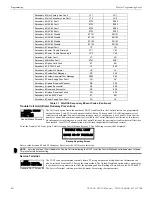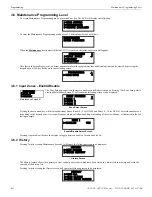
Operating Instructions
Time Functions: Real-Time Clock
System Alarm Verification
The control panel may be programmed to perform alarm verification to help eliminate the nuisance of false alarms. Alarm verification
applies to smoke detectors only.
4.13 Time Functions: Real-Time Clock
The FACP includes a crystal-based clock that provides time of day, date and day of week. Time is displayed as 12 or 24 hour time with
month/day/year and is stored in RAM. Daylight savings time change-over is programmable and automatic. If both AC and battery are
lost, the time must be reprogrammed.
4.14 Coded Operation
The NAC circuits resident on the control panel main circuit board can be programmed for coded operation. The available pulse rates
which can be programmed for coded operation are as follows:
•
Continuous:Steady output with no pulsing
•
March Time:Pulses at 120 ppm (pulses per minute)
•
Temporal Code:Pulses at ½ second On, ½ second Off, ½ second On, ½
second Off, ½ second On, 1½ second Off
•
California Code:10 seconds On, 5 seconds Off
•
Two-Stage:Pulses at 20 ppm (pulses per minute) for 3 or 5 minutes
and then changes to Temporal
4.15 Presignal
Presignal option programs an initiating device to delay the activation of NACs while allowing visual verification by a person. Once a
detector triggers an alarm, the onboard piezo sounds immediately, but the NACs are not activated for a user programmed time duration
of up to three minutes. Note that the alarm relay and communicator will respond to the initial alarm immediately.
After the programmed delay, the NACs will activate if the source of the alarm is not cleared. Note that if a second alarm occurs during
the programmed time delay, the alarm will be processed immediately, causing activation of the NACs. The events which occur upon
Presignal activation are as follows:
onboard piezo sounds immediately
control panel LCD display will indicate a presignal event and the active zone
annunciators (if enabled) will sound the local piezo, and pulse the alarm LED and zone LED
outputs (NACs) of associated zones will be inhibited from activating for a user programmed time delay of up to three minutes
second alarm occurring anytime during the time delay will cause immediate activation of all associated outputs
Presignal operation requires the approval of the local Authority Having Jurisdiction.
4.16 Positive Alarm Sequence
PAS (Positive Alarm Sequence) option will program a smoke detector to delay panel activation (including alarm relay and communica-
tor) for a period of 15 seconds.
When a detector triggers an alarm, the onboard piezo sounds immediately, but the NACs are prevented from activating for 15 seconds.
This inhibit time is factory set and cannot be changed. Pressing the Alarm Silence or Acknowledge/Step key during the 15 second inhibit
time will silence the piezo sounder and start a timer which prevents activation of NACs for an additional time duration which can be user
programmed for up to three minutes. After the programmed delay, the NACs will activate if the source of the alarm is not cleared. Note
that if a second alarm occurs during either time delay, the alarm will be processed immediately, causing activation of the NACs. The
events which occur upon PAS activation are as follows:
onboard piezo sounds immediately
control panel LCD display will indicate a PAS event and the active zone
annunciators (if enabled) will sound the local piezo, and pulse the alarm LED and zone LED
outputs (NACs) of associated zones will be inhibited from activating for a factory set duration of 15 seconds
pressing the Alarm Silence or Acknowledge/Step key will start a timer which inhibits output activation for additional time delay
of up to three minutes which is user programmable
second alarm occurring anytime during either time delay will cause immediate activation of all associated outputs
PAS operation requires the approval of the local Authority Having Jurisdiction.
4.17 Special System Timers
4.17.1 Silence Inhibit Timer
This option, if selected, prevents the
Alarm Silenced
and
Reset
keys from functioning for 60 seconds following an alarm. A new alarm
during the initial 60 second period will not cause the timer to restart with a new 60 seconds.
Silence Inhibit operation requires the
approval of the local Authority Having Jurisdiction.
90
GF505 & GF510 Manual —
P/N
53164
:B5 6/12/2018
















































